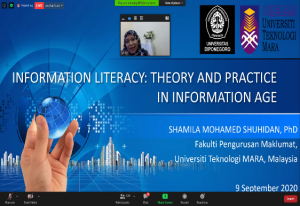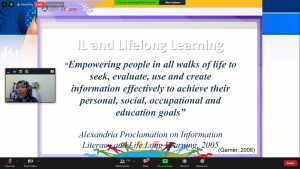Semarang, September 9th 2020-Even though there is a pandemic, this has not dampened the enthusiasm of students, especially students, to deepen their knowledge. Therefore, the Diponegoro University Library Science Study Program collaborated with the Mara Technology University by holding a Visiting Virtual Lecturer activity in the form of a webinar through the Zoom platform with a quota of 280 people. This webinar is intended for Library Science students from various universities. But not only students, lecturers are also allowed to take part in these activities.

Today’s webinar carries the theme “Information Literacy VS Digital Literacy” which is filled by Dr. Shamila Mohamed Shuhidan from Mara Technology University and moderated by Mr. Yanuar Yoga Prasetyawan as a lecturer in Library Science, Diponegoro University. This webinar has a duration of 1.5 hours with an allocated time of 60 minutes for material delivery and 30 minutes for questions and answers.
In the webinar, Dr. Shamila explained about the development of information literacy including what standards and skills a person needs to become a literate person in the information age. This topic is also associated with digital literacy, namely digital information literacy.
According to Mrs. Shamila, information literacy and digital literacy have different definitions. Information literacy contains how a person finds, evaluates, and uses and manages information, while digital literacy is more about the use of digital technology in processing information. In addition, according to him, skills in information literacy are important to be honed because they are long-life learning. When a person becomes an information literate society, he can achieve all his goals until the end of his life. This is what causes information literacy to be very important to be taught to students in schools and colleges as well as in the world of work such as workers. People must be able to adjust their literacy level according to their respective fields. Dr. Shamila advised that “Dont Share if You Dont Sure”. Which means that if we are in doubt about an information then don’t disseminate it first until we can find the truth (facts).

After the material session, the webinar activity was continued with a question and answer session between the presenters and participants by asking questions through the chat box which was then changed to activate the hand-up feature and turn on the camera to ask questions directly which was guided by the moderator. The event ended with a photo session with 128 participants who took part in the webinar.
